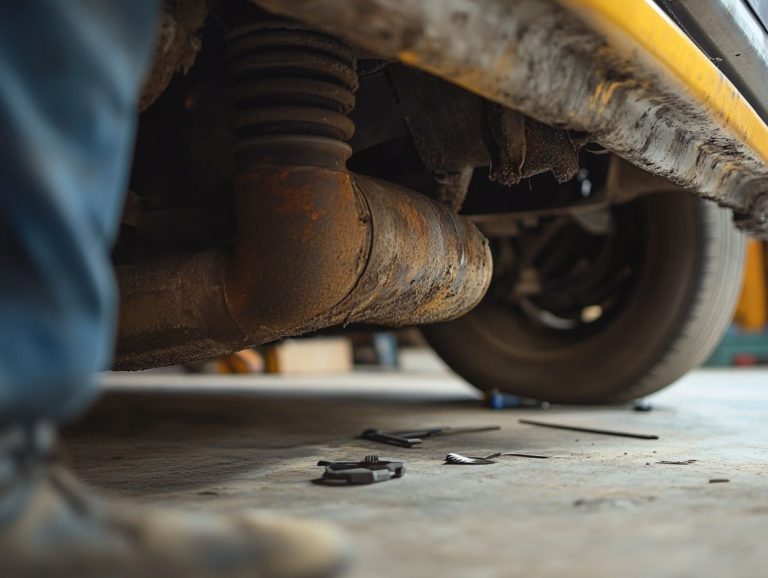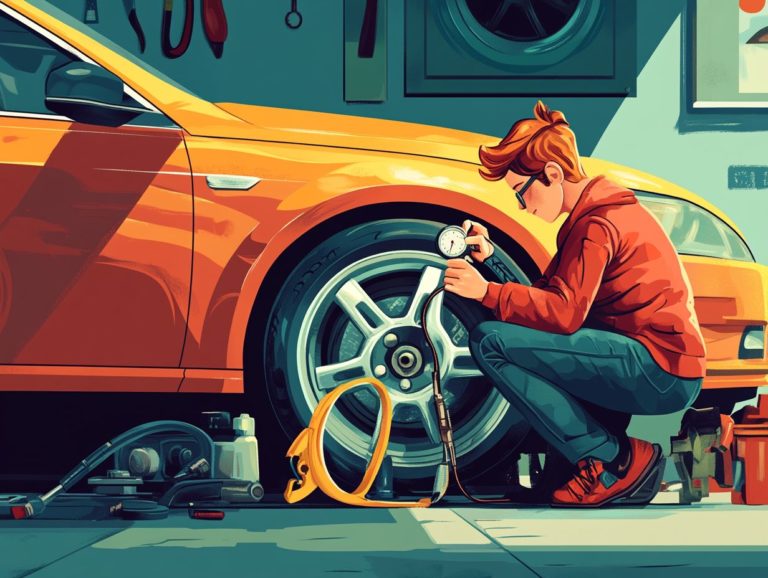How to Properly Store Your Car?
Storing your car may seem like a simple task, but getting it right can truly make a significant difference.
Whether you’re protecting your vehicle during a long trip, the winter months, or just taking an extended break, recognizing the importance of proper car storage is vital.
This guide will highlight the advantages of effective storage practices and assist you in selecting the ideal location.
It will also cover essential techniques for long-term storage, emphasize the significance of regular maintenance, and offer guidance on what to do before you hit the road again.
Let’s ensure your car remains in great shape, ready to accompany you on your next adventure!
Contents
- Key Takeaways:
- Importance of Proper Car Storage
- Preparing Your Car for Storage
- Choosing the Right Storage Location
- Proper Techniques for Storing a Car
- Regular Maintenance during Storage
- Preparing Your Car for Use after Storage
- Frequently Asked Questions
- What is the best way to store my car for an extended period?
- Should I disconnect my car battery before storing my car?
- How often should I start my car when it’s in storage?
- What steps should I take to prepare my car for storage?
- Is it necessary to cover my car when storing it?
- Can I store my car outside?
Key Takeaways:

- Proper car storage is crucial for maintaining the condition and value of your vehicle. Improper storage can lead to costly damage and decreased performance.
- Before storing your car, take necessary steps such as changing the oil, filling the gas tank, and disconnecting the battery. These preparations will help prevent issues during storage.
- When choosing a storage location, consider factors like climate, security, and accessibility. A clean, dry, and well-ventilated space is ideal for long-term storage.
Importance of Proper Car Storage
Proper car storage is essential for preserving the long life and performance of your vehicle. Whether you’re preparing for a driving hiatus, winter storage, or simply seeking secure accommodations for an idle car, understanding effective storage techniques can protect against damage and keep your vehicle in peak condition.
Ignoring proper car storage practices can lead to issues like rust, battery deterioration, or tire degradation. These problems can compromise your vehicle’s performance and safety on the road.
Benefits and Consequences of Improper Storage
Understanding the benefits of proper storage can change how you see the consequences of neglecting your vehicle’s care. When you skimp on maintenance during storage, you risk facing costly repairs, rising insurance rates, and a significant drop in your car s value.
Storing your vehicle in optimal conditions can dramatically reduce maintenance costs and boost its long-term reliability. A well-maintained environment prevents rust from taking hold, which can quickly damage vital metal components. Keeping pests away protects your car s interior and wiring from unwanted damage.
Conversely, overlooking these crucial practices can lead to accelerated depreciation. Vehicles exposed to the elements and pests often end up needing expensive restorations. By taking these steps seriously, you can preserve your investment and ensure a safer, more reliable driving experience.
Preparing Your Car for Storage
Preparing your car for storage is an important step to ensure it remains in optimal condition, whether you re opting for short-term, medium-term, or long-term storage.
Key measures include:
- Inspecting under the hood
- Filling up the gas tank
- Inflating the tires
- Implementing battery protection to prevent any potential damage
By taking these precautions, you can significantly preserve your vehicle’s performance and longevity, making sure it s ready to hit the road when you are.
Don t wait! Get started on storing your car right today to keep it safe for your next journey!
Steps to Take Before Storing Your Car
Before storing your car, take essential steps to keep it in top shape. Start with a thorough wash and vacuum to maintain its pristine appearance.
Change the oil and check the lights, as these simple tasks help your vehicle run smoothly. It’s crucial to top off all fluids, including coolant and brake fluid, to prevent corrosion and seal damage.
Disconnecting the battery helps avoid drainage. Inflate the tires to the recommended pressure to prevent flat spots.
A protective cover will safeguard your car from dust and scratches. Consider using fuel treatment to protect the fuel system during storage.
By following these steps, you will enhance your vehicle’s longevity and ensure it s ready for your next adventure!
Choosing the Right Storage Location

Selecting the perfect storage location for your vehicle is crucial. It protects your car from the elements and potential damage, whether you re considering winter or summer storage.
Opting for safe storage solutions like indoor parking shields your vehicle from rust and deterioration. This ultimately ensures its longevity and pristine condition.
Factors to Consider
When selecting a storage location, consider several critical factors, including weather conditions, accessibility, and insurance implications. Each of these elements plays a significant role in ensuring your vehicle remains protected.
Weather conditions are paramount. Extreme temperatures and humidity can lead to rust, mildew, and paint damage. Ensure that the storage facility offers appropriate climate control to safeguard your vehicle.
Accessibility is equally important. Choose a location that s easy to reach, saving you time and reducing the hassle of retrieving your vehicle.
Understanding the insurance implications tied to different storage options provides invaluable peace of mind. Coverage often hinges on location security and environmental risks, influencing your choice.
By carefully considering these elements, you protect both your vehicle’s condition and your peace of mind.
Proper Techniques for Storing a Car
Act now to implement the right techniques for storing your car! These are crucial for maintaining its value and performance, especially for long-term storage.
- Utilizing a quality car cover: Protects your vehicle from dust and scratches.
- Employing tire stoppers: Prevents flat spots on tires.
- Securing your car in a protected location: Shields it from the elements.
Best Practices for Long-Term Storage
In terms of long-term car storage, following best practices mitigates the risk of deterioration and damage. Use a gas stabilizer, check your wipers, and apply a wax coating to keep your vehicle in pristine condition.
To ensure your battery remains in top shape, either disconnect it or use a battery maintainer to prevent draining. Elevating your vehicle on jack stands helps avoid flat spots on the tires during extended inactivity.
Regularly inspect and inflate your tires to the recommended pressure for overall vehicle health. Covering your car with a breathable fabric protects it from dust and moisture buildup.
By implementing these maintenance tasks, you extend your vehicle’s lifespan and enhance its resale value when the time comes.
Regular Maintenance during Storage
Regular maintenance during car storage is crucial for keeping your vehicle in excellent condition while it’s taking a break from the road.
Routinely inspect your car, check under the hood, and safeguard the battery. These proactive measures help prevent potential issues during those extended periods of inactivity.
Preventative Measures to Keep Your Car in Good Condition

Implementing preventative measures is essential for maintaining your car’s functionality and preventing deterioration during storage. Key actions include:
- Topping off fluids
- Regularly testing your battery
- Ensuring secure storage to protect your vehicle from potential threats
Investing in a high-quality car cover shields your vehicle from dust, rain, and sun damage. This is especially vital in harsh weather conditions. It’s also wise to maintain proper tire pressure. Flat spots can develop if the car sits idle for too long.
Establish a routine to start the engine occasionally. This helps keep the engine components lubricated and the battery charged.
By taking these steps, you ll extend the lifespan of your vehicle and enhance its overall performance when it s time to hit the road again.
Preparing Your Car for Use after Storage
After a period of storage, preparing your car for use requires a series of steps to ensure it s ready for safe driving. Start by removing any coverings. Then, check the lights and inspect the vehicle thoroughly.
This meticulous attention to detail confirms that your car is in optimal condition for the road ahead.
Steps to Take Before Driving Your Car Again
Before you hit the road again, ensure your car is safe and ready for driving. This includes checking under the hood, inflating the tires, testing the battery, and washing your ride for optimal visibility.
Address these steps methodically, as they significantly impact your vehicle’s overall performance and safety. Start with an inspection of fluid levels: check the oil, coolant, and brake fluid to avoid any unforeseen complications.
Next, examine your tires. Look for proper inflation and any signs of wear or damage.
A thorough evaluation of your battery’s condition can help you avoid unexpected failures. A clean exterior enhances visibility and showcases a well-maintained vehicle.
By following these guidelines, you ll ensure that your car is ready and safe for your journey.
Frequently Asked Questions
What is the best way to store my car for an extended period?
To store your car for an extended period, keep it in a cool, dry, and well-ventilated area. This prevents moisture build-up and potential damage to your car’s exterior and interior.
Should I disconnect my car battery before storing my car?

Yes! To keep your battery healthy, disconnect it before storing your car. This prevents the battery from draining and protects its lifespan.
How often should I start my car when it’s in storage?
Start your car at least once every two weeks. This keeps the engine and other mechanical components lubricated and prevents potential issues.
What steps should I take to prepare my car for storage?
Before storing your car, clean it thoroughly, change the oil, top off all fluids, and fill the gas tank. Remove any valuable items and cover your car with a breathable car cover.
Is it necessary to cover my car when storing it?
Yes! Cover your car to protect it from dust, debris, and potential scratches. Use a breathable car cover to prevent moisture build-up.
Can I store my car outside?
It’s not recommended to store your car outside. Exposure to the elements may cause damage from weather conditions. If possible, store your car in a garage or covered carport.






